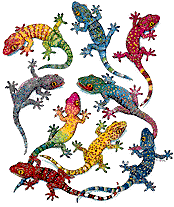|
|
Listed below are two of the most common health problems that
reptile keepers encounter. Please pay close attention to the
causes listed. Preventing illness is always better than
trying to cure it and many health problems can be fairly
easily prevented by researching and applying the advice of
experienced keepers and by good housekeeping and husbandry
on your part.
*** Mouth Rot (Ulcerative stomitus)
Mouth rot is more commonly a problem in snakes, as their
mouths are sometimes injured in the feeding process and so
are more prone to infection. The first symptom of ulcerative
stomitus is usually swelling in the soft mouth tissues, and
if it is not treated it can spread to the bones of the head
and permanently damage the jaw, gums and teeth.
Other possible symptoms include a grayish, cheesy-looking
substance in the mouth, and/or the animal keeping its mouth
open for extended periods. Causes may include damage to the
mouth by prey or other animals or by a stressed animal
banging its head against the cage. Poorly cleaned cages can
contribute to the infection.
As soon as you see any of these symptoms, transfer the
animal to an isolation/hospital cage and either buy the
proper medicine from your pet store and apply it according
to the directions, or if the case is extreme or the animal
is hard to manage, take the animal to your reptile
veterinarian for immediate treatment.

***Ventral Scale Rot (Ulcerative dermatitis)
Ventral Scale Rot causes appetite loss and red patches,
sores or blisters on the ventral scales (scales near the
animal's vent or cloaca).
Ulcerative dermatitis is commonly caused by too much
moisture in the tank, such as substrate that stays
constantly damp and/or a growth of bacteria and mold
encouraged by under-tank heating and a tank that is not kept
clean enough. Basically this means that the animal has been
forced to lie on infected material and the microbial growth
has spread to your pet.
The first step in a cure, then, is to transfer the animal to
an isolation/hospital tank that has no substrate but layers
of paper towels or the like to stop the irritation, and
clean the animal's wounds daily with clean warm water and
apply a suitable reptile medication. Again, if the infection
is major, get to a reptile vet immediately.
Meanwhile, completely clean and sterilized the original
tank, and replace the substrate with fresh material. For
future prevention, check the humidity level that the tank
stays at to make sure it is optimum, watch the animal
carefully for signs of future problems, and keep the tank as
spotlessly clean as possible.
|